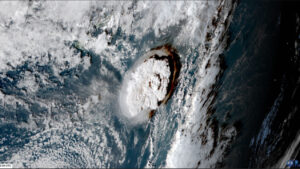Hunga Tonga erupted on Jan. 15 and lasted 11 hours.

It devastated the region, covering the land in a layer of ash. The eruption blasted a plume of ash and water vapor 34 miles into the atmosphere — into the mesosphere.
The Hunga Tonga plume contained only a very small amount of sulfur dioxide (SO2). Sulfur dioxide from volcanic mega-eruptions that reach high in the atmosphere can have an impact on global temperature. The mega-eruption of Pinatubo in 1991 released enough sulfur dioxide to cool the Earth’s surface for three years. The Tonga eruption will not have that kind of impact.
Lightning is common with volcanic eruptions. The turbulence in the eruption plume makes particles of ash and water collide to rub together, generating electrical charges that lead to lightning. Hunga Tonga was no exception, producing nearly 400,000 lightning strikes.
The shockwave from the eruption caused an atmospheric pressure wave that traveled around the globe. It was measured at weather stations around the world. The pressure wave circumnavigated the globe at nearly 700 mph. Associated with the pressure wave were short-lived upward motions that generated thin clouds observed at Hawaii. Satellite observations measured temperature fluctuations in the upper troposphere and lower stratosphere that accompanied the pressure wave.
The atmospheric pressure wave also pushed water all the way to Puerto Rico. This resulting wave, measuring about 4 inches in height, resulted from the atmospheric pressure wave and is referred to as a meteotsunami. Tsunamis are triggered by seismic activity; water waves driven by air pressure disturbances are called meteotsunamis.
Steve Ackerman and Jonathan Martin, professors in the UW-Madison department of atmospheric and oceanic sciences, are guests on WHA radio (970 AM) at 11:45 a.m. the last Monday of each month. Send them your questions at stevea@ssec.wisc.edu or jemarti1@wisc.edu.

